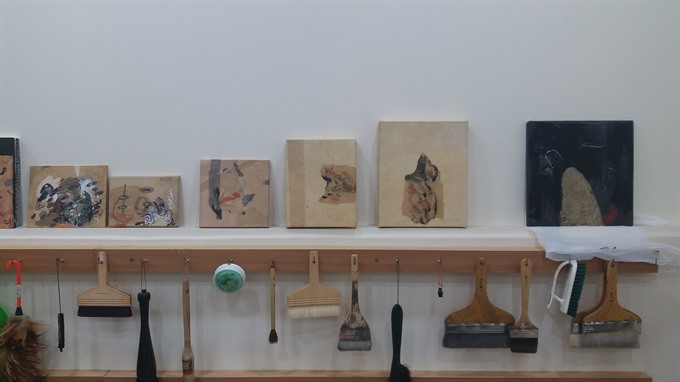Viet Nam News
A recent exchange camp hosted by the Ministry of Culture, Sports and Tourism was attended by 22 artists from 11 Asian countries.
Le Huong chats with visual artist Ruchika Wason Singh from India about her work and her research on Vietnamese do (poonah) paper. Trained as a painter and a printmaker at the College of Art, New Delhi, India, she did her Ph.D research in Indian contemporary art.
How did you find out about do paper, and why did you decide to research it?
I am interested in different kinds of traditional handmade papers. I had already worked with Chinese Xuanjhie paper, Nepalese Lokta paper, Japanese Washi paper and Korean Hanji paper.
In 2016, my artist friend in Ha Noi, Luu Bao Trung, sent me some samples of do paper.
It was a co-incidence because at the same time, I had also received an invitation to take part on the Month of Art Practice International Artist Residency Programme at Heritage Space in Ha Noi.
I experimented with do paper in India. Finally I decided to make my artist residency proposal based on my research of do paper. The residency gave me the time and space needed to research and bring it into my art practice.
Tell me about your research on do and your findings
My research on do paper began with many failures, because I kept trying to use it and looking for the same results as the Chinese, Japanese and Korean papers.
I thought it would or should work the same way.
But do has its own possibilities and so I learnt, that as an artist, I had to submit to the nature of the paper and take my research further.
The research included looking for varieties of do paper available in Ha Noi.
I visited the Yen Thai paper making village in Ha Noi. I must acknowledge, it was not possible without the support of the Heritage Space Volunteer Team.
I also visited artist studios and learnt from them – including Ms. Dinh Thi Tham Poong, Mr Nguyen The Hung and Mr Luu Bao Trung
I experimented with do on different surfaces such as canvas, other papers and surfaces such as traditional Vietnamese paper masks.
I used Chinese ink and watercolour to paint on do. I also tried collage.
Firstly, it does not give the same fluidity to paint as Chinese, Korean or Japanese paper. Do needs to be painted upon with gum arabic or needs to be sized with gum Arabic first.
It works beautifully when its used in layers one on top of the other.
Finally, it is up to the artist, because each artist is looking for one’s own results and my search could be totally different from that of another.
 |
| Creativeness: Some works on Vietnamese do paper are on painting process at the artist’s home. The first one from right will be exhibited at the Louvre Museum in Paris in December 2018. —Photo courtesy of the artist. |
What do you think about the possibilites of co-operation between Vietnamese and Indian artists? What can you do for that purpose personally?
In my opinion, artistic exchange is a natural, spontaneous and productive mode of dialogue and co-operation.
Already, personally, as in the MAP Residency (2017) and also the International Workshop (2018), I have brought traditional materials from India such as paper and brushes used for Jaipur miniature paintings.
These artistic exchanges can help each of us grow, learn and respect the art and culture of one other, which I find important in today’s times of conflict in the world.
It will go a long way to creating and sustaining our artistic heritage.
With support from Viet Nam’s culture ministry, I propose a workshop where artists of one country work with traditional art materials from another country.
What do you think about Viet Nam’s contemporary art and painting?
My awareness and knowledge of contemporary art of Viet Nam is limited. But from my experience, I can say that it’s a space that is buzzing slowly and steadily.
There is a range - artists are continuing with practices with traditional materials and blending them with modern materials and contemporary themes such as Vuong Thao.
At the same time, new experimentations by artists such as Uu Dam Tran Nguyen are very important.
The role of the State – supported patronage such as that from the Ministry of Culture, Sports and Tourism and private art galleries such as Art Vietnam Gallery and Manzi are creating platforms for contemporary art.
At the same time, I see a new wave of art spaces such as Heritage Space and the Vincom Center for Contemporary Art (both in Ha Noi), which have fresh ideas with a global perspective on artistic presentations for the public and the art community, which I feel are indispensable.
Please tell me about your research project - The Archive for Mapping Mother Artists in Asia (AMMAA)!
t is the research project that I initiated in 2016. It is aimed at bringing attention to maternal feminism, within the discourse of feminist art history in Asia.
This is an unexplored area which needs much attention; because it opens new trajectories of questions on hierarchy, identity, negotiations of time and space within feminist art practice as well as contextual frameworks in the art of female artists.
The project website www.ammaathearchive.com serves as an online database.
Further the project organises workshops and an international residency programme, which provides platforms for the mapping, visibility and mobility of mother artists of Asian origin, living within/outside of Asia.
The project aims to provide strength and support to women, who have taken up the challenge to find a balance between motherhood and artistic practice in their lives.
The project is now growing with Nguyen Anh Tuan as the international advisor (from Viet Nam) for AMMAA ; with a hope to expand the scope of the project in Viet Nam and in Asia. — VNS